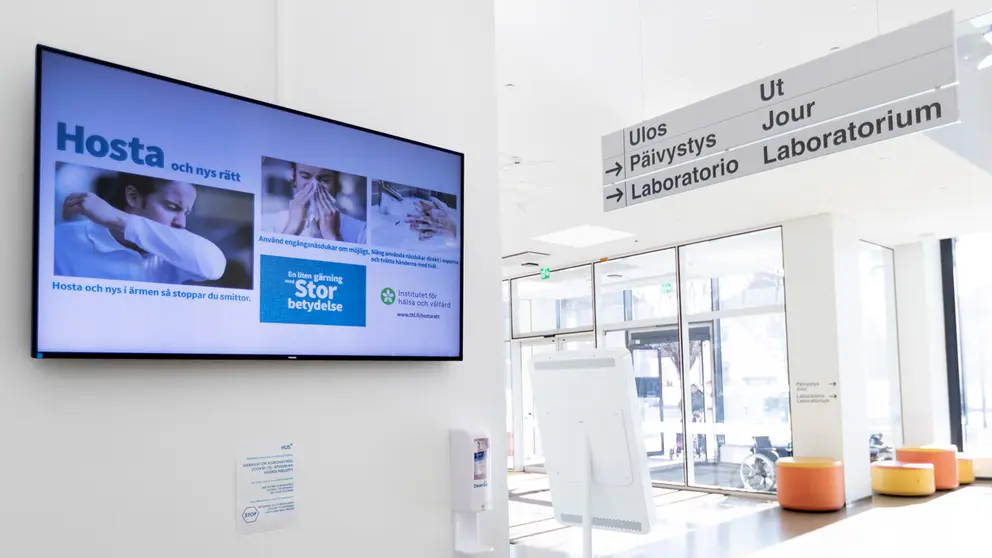The government submitted to Parliament its proposal to reform health and social services on Tuesday 8 December.
The Ministry of Social Affairs and Health says that the aim of the reform is to reduce inequalities in health and wellbeing; safeguard equal and quality health, social and rescue services for all; improve the availability and accessibility of services; ensure the availability of skilled labor; respond to the challenges of changes in society; curb the growth of costs; and improve safety.
The proposal establishes that wellbeing services counties be established and healthcare, social welfare and rescue services be reformed.
The proposed counties would be created as soon as possible after the passing and approval of the relevant bills. The bills would enter into force in stages, the first ones on 1 July 2021 and the last ones on 1 January 2023.
21 counties to be established
In line with the government proposal, 21 wellbeing services counties would be established in Finland and entrusted with the health, social and rescue services duties that are currently the responsibility of municipalities and joint municipal authorities.
A total of 4 wellbeing services counties would be established in the region of Uusimaa, based on the special arrangements made for this area. The city of Helsinki would also in the future be responsible for organizing healthcare, social welfare and rescue services.
In addition, the joint county authority for the hospital district of Helsinki and Uusimaa would be responsible for organizing specialized medical care in Uusimaa.
The responsibility for organizing healthcare would be divided between the wellbeing services counties in the region, the city of Helsinki and the joint county authority for the hospital district of Helsinki and Uusimaa as separately laid down by law and in an agreement on the organization of services.
In the wellbeing services counties, rescue services would be a separate sector working in parallel with the healthcare and social welfare sector. The level of rescue services should correspond to national, regional and local needs and the counties should prepare for accidents and threats in their areas.
Hospital districts operation transferred
The operation of hospital districts and special care districts would be transferred to the wellbeing services counties.
Similarly, the responsibility for organizing the services of school social workers and school psychologists would be transferred to the wellbeing services counties. Both the wellbeing services counties and the municipalities would be in charge of promoting health and wellbeing. The municipalities would assume responsibility for the organization of environmental healthcare as a whole.
A county council, elected by direct popular vote, would be the highest decision-making body of wellbeing services counties. The activities of each wellbeing services county would be managed in accordance with the strategy for the wellbeing services county approved by the relevant county council, which would also decide on the organizational structure of the county.
Emergency response
According to the proposal, the counties should have sufficient competence, functional capacity and readiness to take responsibility for organizing health, social and rescue services in all situations, including incidents and emergencies.
The counties should have in their employment all the necessary professionals and other personnel. They should also have appropriate premises and tools at their disposal and ensure other necessary working conditions. In addition, the counties should have a sufficient service provision of their own in the healthcare and social welfare sector but they would not be required to maintain overcapacity.
The responsibility for organizing services would include the responsibility for statutory duties; decision-making; the supervision of the provision of services; the integration of services; and the exercise of powers assigned to the counties as public authorities. The wellbeing services counties would also assume responsibility for preventive healthcare and social welfare, training and research, preparedness for incidents and emergencies and the security of supply, among other things.
The counties would be public law entities that have autonomy in their areas. In mainland Finland, the areas of the new wellbeing services counties would correspond to those of the current regions, but the region of Uusimaa would be divided based on the decision on special arrangements.
Purchasing health, social services
The wellbeing services counties could purchase health and social services for clients from private service providers based on an agreement, if that was necessary to perform their duties appropriately. The content, scope and quantity of the services to be purchased should be such that the counties could, in all situations, fulfil their responsibility for organizing services.
The counties could not purchase from private service providers services relating to duties fulfilling the responsibility for organizing services or the management of public administrative duties, social work, emergency social services or primary and specialized 24-hour healthcare services. However, the counties could procure labor and temporary agency workers in 24-hour emergency services to supplement their own personnel.
Private service providers should fulfil the conditions laid down in the Private Healthcare Act and the Act on Private Social Services. The counties would supervise private service providers and their subcontractors. Private service providers would also supervise their subcontractors.
Central government guidance
The central government would confirm the strategic objectives of healthcare, social welfare and rescue services every four years. The counties should take the objectives into account in their own activities and also when preparing cooperation agreements.
An advisory board for healthcare and social welfare would be established under the Ministry of Social Affairs and Health. The government would appoint the board for a term of four years. Its task would be to monitor and assess the fulfilment of health and social services duties and support the national guidance and direction of healthcare and social welfare.
Similarly, an advisory board for rescue services would be established under the Ministry of the Interior. Its task would be to monitor and assess the fulfilment of rescue services duties and support the national guidance and direction of rescue services.
The Ministry of Social Affairs and Health, the Ministry of the Interior and the Ministry of Finance would hold annual negotiations with each wellbeing services county.
Each county would draw up an annual investment plan, and the Ministry of Social Affairs and Health and the Ministry of the Interior would decide whether to approve it. An approved investment plan would be a requirement for new investments and asset transfers in the county.
Funding the reform
One of the objectives of the health and social services reform is to curb the growth of general government expenditure. However, major reforms always cause significant transition costs. Taking into account all costs arising from the reform, the reform would weaken the balance in general government finances in the 2020s, after which the government expects that costs would start decreasing.
The operation of wellbeing services counties would be financed mainly from central government funds and partly from client fees to be collected from the users of services.
The funding of wellbeing services counties would be universal. It would be divided among the counties based on imputed factors describing the service needs and conditions. Some of the funding would be based on population numbers and some would be determined by the criteria for health and wellbeing performance. The funding of rescue services would also be determined on the basis of a risk coefficient.
The imputed funding for healthcare and social welfare would be based on the service need coefficients that describe the need for healthcare, social welfare and services for older people. In calculating these coefficients, account would be taken of the information on the age and gender structure, morbidity and socio-economic factors of the population and their use of services as well as the costs arising from the use of services.
The needs-based factors incurring healthcare and social welfare costs along with their weighting coefficients would be determined so that each factor would have different weighting coefficients based on how common they are and how high the costs are. In healthcare, for example, the needs-based factors would include a total of about 50 diseases that are significant in terms of costs. Socio-economic factors describing income, education and training, single-parent family, marital status, one-person household and main activity would also be considered as new needs-based factors more broadly than the current system of central government transfers for basic public services.
Transferring the responsibility for funding from municipalities to the central government would mean that the central government revenue would need to be increased and, at the same time, the revenue of municipalities would need to be reduced to correspond to the responsibility for funding transferred from them.
To prevent the total tax ratio from rising, all municipalities would be obligated to reduce the municipal income tax. The reduction would be 13.26 percentage points in all municipalities. Moreover, the municipalities’ share of corporation tax revenue would be reduced and the state’s share would be increased correspondingly. The changes in taxation would be as neutral as possible from the standpoint of taxpayers, the government says.
Organization of rescue services
According to the government proposal, rescue services would in future be organized by the wellbeing services counties and the city of Helsinki, which would also be responsible for organizing healthcare and social welfare in their areas. Rescue departments could continue to provide prehospital emergency medical services for healthcare. Currently, the rescue departments carry out approximately 500,000 urgent prehospital emergency medical care duties every year.
Rescue services would, however, continue to be a separate sector working in parallel with the healthcare and social welfare sector.
As a result of the reform, the role of central government guidance and direction in rescue services would be strengthened. Stronger national guidance and direction would improve the provision of more harmonized and thus more equal rescue services throughout the country. The aim is also to develop the operations of rescue services as a national system.
Personnel transfers, labor costs
The reform would entail major organizational changes and changes in the services that would materially affect the duties and placement of personnel. In 2023, about 172,900 people currently employed by 332 municipalities or joint municipal authorities would be transferred to the employment of the wellbeing services counties in line with the transfer-of-business principle.
Based on 2018 statistics, the labor costs of personnel affected by the reform are estimated to be around 10.7 billion euros per year, which is about 52% of all labour costs in municipalities and joint municipal authorities.
All healthcare and social welfare personnel and their tasks would be transferred from municipalities and joint municipal authorities to the employment of the wellbeing services counties.
School social workers and school psychologists working in the education sector in municipalities would also be transferred to the employment of the counties. Personnel would be transferred from joint municipal support services to the employment of the wellbeing services counties if at least half of their present duties were devoted to municipal health, social or rescue services. Personnel would be transferred in accordance with the transfer-of-business principle so that at the time of the transfer they would retain their current rights and obligations under the terms of their employment or public service relationships.
Timetable
The proposed wellbeing services counties would be established as soon as possible after the entry into force of the implementation act.
The government proposes that the act enter into force on 1 July 2021. The joint county authority for the hospital district of Helsinki and Uusimaa would be established through an agreement approved by the wellbeing service counties of the region of Uusimaa and the city of Helsinki. The first county elections would be held on early in the year 2022. The county elections would not apply to the residents of the city of Helsinki.
At the first stage, the counties’ provisional governance and, after the county elections when the county councils would start their work, the counties would prepare the organization of their activities and the transfers of personnel and assets jointly with the municipalities and joint municipal authorities. The responsibility for organizing healthcare, social welfare and rescue services and other services and duties to be stipulated separately would be transferred to the wellbeing services counties from the beginning of 2023.
The aim is for the bills included in the proposal to enter into force in stages so that some of them would enter into force on 1 July 2021 while others would enter into force on 1 March 2022 when the new county councils would start operating. The last bills would enter into force on 1 January 2023.











